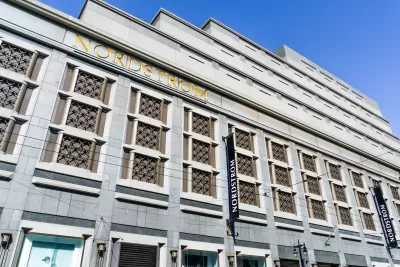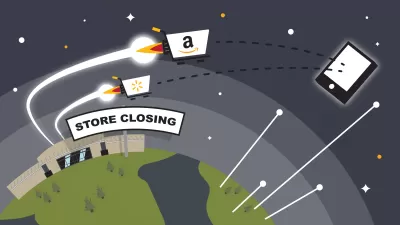While some cling to debatable claims about higher crime rates as the cause for recent high-profile store closures in U.S. downtowns, the real reasons are more realistically extensions of the causes of the “retail apocalypse” from the before times.

Major retailers like Nordstrom, Whole Foods, CVS, Starbucks, and Walmart have been announcing store closures in U.S. downtowns in recent weeks and months, contributing to the ongoing narrative about the “urban doom spiral” afflicting many U.S. cities as living patterns shift as a result of the Covid-19 pandemic.
According to an article by Nathaniel Meyersohn for CNN, “Several forces are pushing chains out of some city centers: a glut of stores, people working from home, online shopping, exorbitant rents, crime and public safety concerns, and difficulty hiring workers.”
The solution, according to the article, is more residents, in denser neighborhoods, argues Meyersohn, “with a broader mix of affordable housing, experiential retail, restaurants, entertainment, parks and other amenities.”
The article also argues that from the list above, the effect of crime has likely been overstated in the media, while a glut of stores has been understated. “Walgreens said it saw a spike in losses, known as shrink, during the pandemic and cited organized retail crime in its decision to close five San Francisco stores in 2021. But it recently backtracked,” writes Meyersohn.
Also noteworthy, according to the article, is the duration of the recent history of store closures—it predates the onset of the pandemic by several years, in fact. “San Francisco, Los Angeles, San Diego, New York City, Seattle, Miami and Chicago lost retail stores from the beginning of 2017 to the end of 2021, according to research from the JPMorgan Chase Institute, a think tank.”
One with a memory of the before times might recall the “retail apocalypse” that garnered so much attention. “According to Morgan Stanley, from 1995 to 2021, more stores closed every year than opened,” Meyersohn reminds us.
More nuance and data is available at the link below.
FULL STORY: The real reasons stores such as Walmart and Starbucks are closing in big cities

Planetizen Federal Action Tracker
A weekly monitor of how Trump’s orders and actions are impacting planners and planning in America.

Congressman Proposes Bill to Rename DC Metro “Trump Train”
The Make Autorail Great Again Act would withhold federal funding to the system until the Washington Metropolitan Area Transit Authority (WMATA), rebrands as the Washington Metropolitan Authority for Greater Access (WMAGA).

DARTSpace Platform Streamlines Dallas TOD Application Process
The Dallas transit agency hopes a shorter permitting timeline will boost transit-oriented development around rail stations.

Parks: Essential Community Infrastructure — and a Smart Investment
Even during times of budget constraint, continued investment in parks is critical, as they provide proven benefits to public health, safety, climate resilience, and community well-being — particularly for under-resourced communities.

Porches, Pets, and the People We Grow Old With
Neighborhood connections and animal companions matter to aging with dignity, and how we build can support them. Here’s a human-scale proposal for aging in place.

Single-Stair Design Contest Envisions Human-Scale Buildings
Single-stair building construction is having a resurgence in the United States, where, for the last several decades, zoning codes have required more than one staircase in multi-story housing developments.
Urban Design for Planners 1: Software Tools
This six-course series explores essential urban design concepts using open source software and equips planners with the tools they need to participate fully in the urban design process.
Planning for Universal Design
Learn the tools for implementing Universal Design in planning regulations.
City of Charlotte
Municipality of Princeton
City of Camden Redevelopment Agency
City of Astoria
Transportation Research & Education Center (TREC) at Portland State University
US High Speed Rail Association
City of Camden Redevelopment Agency
Municipality of Princeton (NJ)





























